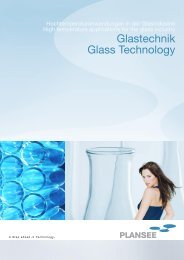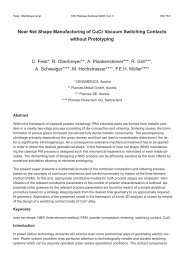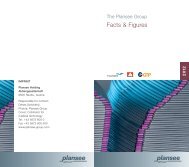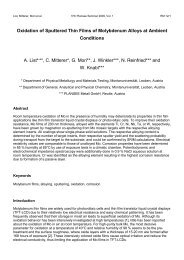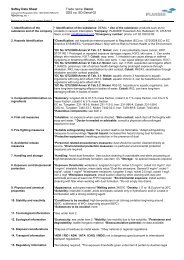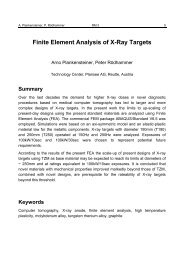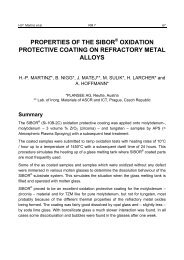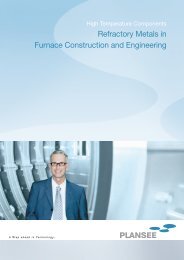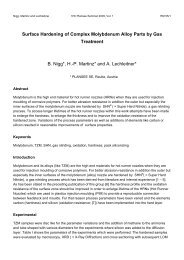Investigation of Solid Solution Hardening in Molybdenum Alloys
Investigation of Solid Solution Hardening in Molybdenum Alloys
Investigation of Solid Solution Hardening in Molybdenum Alloys
Create successful ePaper yourself
Turn your PDF publications into a flip-book with our unique Google optimized e-Paper software.
RM 18/6 17th Plansee Sem<strong>in</strong>ar 2009, Vol. 1 Wesemann, H<strong>of</strong>fmann et al.<br />
The effect <strong>of</strong> dielastic <strong>in</strong>teraction was characterised by the measurement <strong>of</strong> change <strong>in</strong> modulus <strong>of</strong><br />
rigidity. The modulus <strong>of</strong> rigidity G can be determ<strong>in</strong>ed by velocity <strong>of</strong> transversal ultrasonic waves cT <strong>in</strong> a<br />
metal with known density ρ. Transversal ultransonic waves show a low transmittance. Therefore an<br />
attempt was made to derterm<strong>in</strong>e G without direct measurement <strong>of</strong> cT at room temperature. Such a<br />
method is described by M. B. Reynolds [11]. Sample diameter d and the time Δt between the 1 st and 2 nd<br />
back wall echo and the velocity <strong>of</strong> longitud<strong>in</strong>al ultrasonic waves cL have to be determ<strong>in</strong>ed. For the<br />
verification <strong>of</strong> the ultra sonic measurements additional measurements were carried out with the<br />
ELASTOMAT. The ELASTOMAT excites the sample with different ultra sonic frequencies and the<br />
resonance frequencies are determ<strong>in</strong>ed. Thereby the modulus <strong>of</strong> elasticity E and the Poisson ratio ν can<br />
be determ<strong>in</strong>ed and the modulus <strong>of</strong> rigidity can be calculated. This comparitive measurement was done<br />
for molybdenum-titanium and molybdenum-tungsten alloys.<br />
The effect <strong>of</strong> gra<strong>in</strong> size harden<strong>in</strong>g was determ<strong>in</strong>ed with a pure molybdenum reference sample as well as<br />
on PLANSEE standard molybdenum rods with a total degree <strong>of</strong> deformation <strong>of</strong> φtotal = 3.4. The gra<strong>in</strong> size<br />
on the molybdenum rods was altered by variation <strong>of</strong> the anneal<strong>in</strong>g temperature between 1300°C and<br />
2300°C. Anneal<strong>in</strong>g time was constant for 1 hour. These samples were tested by Vickers hardness HV10<br />
−3<br />
−1<br />
at room temperature and compression tests at 500°C with a deformation rate <strong>of</strong> ε& = 2.<br />
0 ⋅10<br />
s .<br />
Results<br />
Except for the molybdenum-titanium alloys chemical analysis revealed <strong>in</strong>terstitial impurities below 1 ppm<br />
for hydrogen and below 5 ppm for nitrogen, and carbon. The molybdenum-titanium alloys with titanium<br />
content above 2% showed oxygen content <strong>of</strong> 150-350 ppm. SEM analysis <strong>in</strong> comb<strong>in</strong>ation with EDX<br />
revealed oxygen conta<strong>in</strong><strong>in</strong>g titanium particles (presumably titanium oxide) for these alloys even after<br />
apply<strong>in</strong>g a 2300°C anneal<strong>in</strong>g.<br />
Even at 2300°C a complete homogeneous distribution <strong>of</strong> the alloy<strong>in</strong>g elements could not be achieved for<br />
the molybdenum- tungsten and molybdenum-rhenium alloys, although the whole alloy<strong>in</strong>g content was <strong>in</strong><br />
solid solution (EPMA measurements <strong>in</strong> fig. 5 and fig. 6). Particles were observed for molybdenumtantalum<br />
and molybdenum-titanium alloys with high alloy<strong>in</strong>g content after a 2000°C anneal<strong>in</strong>g. After an<br />
additional 2300°C anneal<strong>in</strong>g the molybdenum- tantalum alloys were completely homogenised (EPMA<br />
measurements <strong>in</strong> Fig. 3 and Fig. 4) while very few particles rema<strong>in</strong>ed present <strong>in</strong> the high content<br />
molybdenum-titanium alloys.



